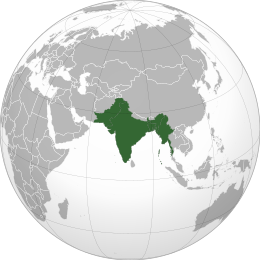More languages
More actions
| British Raj برطانوی راج | |
|---|---|
|
Civil ensign | |
 | |
| Capital | New Delhi |
| Official languages | English Urdu |
| Dominant mode of production | Capitalism |
| Government | Colonial occupation |
The British Raj (sometimes called the Indian Empire) was the period of direct British colonial rule on the Indian subcontinent. It succeeded the British East India Company's rule of India during the late Mughal Empire. During this period, India spent 25% and tax revenues on the military and barely 3% on health, education, and farming combined. British trade destroyed native Indian industries and undeveloped India's economy, increased the amount of Indians reliant on agriculture from 50% to 75%.[1] After 200 years of British occupation, the Indian literacy rate was only 12%.[2]
History
Formation
Following a rebellion of sepoys in 1857, the British government replaced the East India Company as the ruler of India and Queen Victoria Hanover became the Empress of India.[1]
Geography and Division
The British Raj encompassed territories that today include India, Myanmar (formerly Burma), Pakistan, and Bangladesh. It also briefly included Sri Lanka (then called Ceylon), however this was for an extremely short time. Additionally, the British Raj served as the administrative center for several other British colonies, such as Aden (in present-day Yemen) and the Straits Settlements, which covered parts of modern-day Malaysia and Singapore. For a short period, it also oversaw British Somaliland (now part of Somalia). Smaller colonies in Iran were also included. [3]
While most of these were separated rather early on, however Burma and Aden were separated during the late 1930s in order for the British imperialists to weaken anti colonial and international movements amongst the people of India. International and cross cultural solidarity amongst the colonial subjects was harmed by the divide and rule strategy which ensured that Indians from various cultural and religious backgrounds could not collaborate to overthrow British rule (this is best seen the original partition of Bengal as well as the later partition of India itself). The British Empire also used Caste and a racialized system to create further divisions. This eventual lead to the partition of India which divided India by Hindu and Muslim populations into two separate countries. This lead to some of the worst colonial policies and was the largest migration of human beings since the original spreading out of our species.
Another way India was controlled via geographical and population wise divisions by the imperialists was by using the Princely State system by which the bourgeoisie and royals of India could sell their citizens out in order to be an autonomous part of the British Raj which guaranteed them a higher standard of living. [4]
Famines
Famines killed a million Indians in the 1860s, 3.5 million in the 1870s, and 10 million in the 1890s.[1]
Government
Following the end of company rule, the British strengthened their connections to native Indian rulers and relied on Brahmins to collect taxes and rents.[1]
Further reading
References
- ↑ 1.0 1.1 1.2 1.3 Neil Faulkner (2013). A Marxist History of the World: From Neanderthals to Neoliberals: 'The Age of Blood and Iron' (pp. 151–152). [PDF] Pluto Press. ISBN 9781849648639 [LG]
- ↑ Vijay Prashad (2017). Red Star over the Third World: 'Peasant Soviets' (pp. 59–60). [PDF] New Delhi: LeftWord Books.
- ↑ Subodh Kapoor (2002). Indian Encyclopaedia.
- ↑ John McLeod (1994). The English Honours System in Princely India, 1925-1947.

